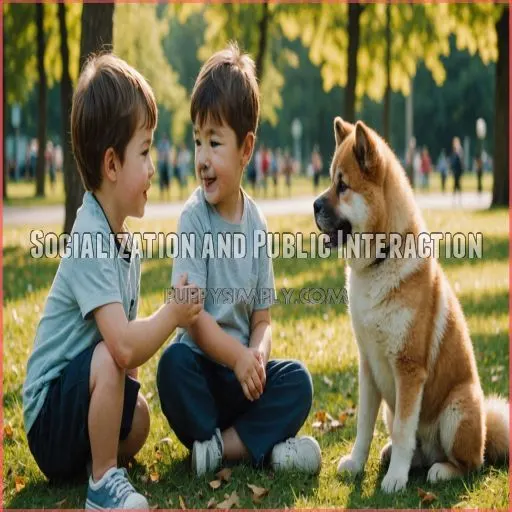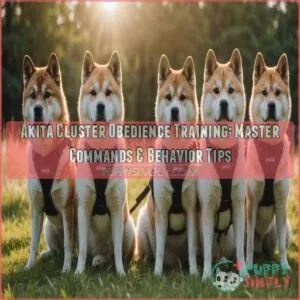This site is supported by our readers. We may earn a commission, at no cost to you, if you purchase through links.
 Training an Akita is like teaching a superhero to use their powers wisely—they’re independent and strong-willed, but with the right approach, they’ll be your loyal sidekick.
Training an Akita is like teaching a superhero to use their powers wisely—they’re independent and strong-willed, but with the right approach, they’ll be your loyal sidekick.
Start with the basics: teach "sit," "stay," and "come" using treats and praise.
They’re smart cookies but can be as stubborn as a mule, so consistency is key.
Embrace their loyalty and intelligence to build a lifelong bond.
Think of training as a marathon, not a sprint.
Want to unravel the mysteries of Akita mastery? Stick around for pro-level strategies!
Table Of Contents
- Key Takeaways
- Akita Training Fundamentals
- Establishing Basic Obedience Commands
- Managing Akita Dominance and Stubbornness
- Socialization and Public Interaction
- Advanced Training and Problem-Solving
- Frequently Asked Questions (FAQs)
- Are Akitas easy to train?
- How do you train an Akita dominance?
- How to discipline an American Akita?
- How to socialize an Akita?
- How can I address an Akitas barking behavior?
- What are effective techniques for leash training Akitas?
- How do I prevent my Akita from jumping on guests?
- What should I do if my Akita shows aggression?
- How to manage an Akitas separation anxiety?
- Conclusion
Key Takeaways
- Understand that Akitas are strong-willed superheroes in disguise, and training them requires consistency, patience, and a treasure chest of treats. Focus on positive reinforcement to shape their behavior and strengthen your bond.
- When it comes to teaching basic commands like "sit" and "stay," remember it’s a marathon, not a sprint. Your Akita might be stubborn like a mule, but with persistence, they will respond to the challenge—and may even surprise you with their hidden brilliance.
- Socialization is your Akita’s all-access pass to the world. From puppy playdates to dog park expeditions, these experiences help them manage public distractions with the poise of a seasoned globetrotter.
- If you hit a stubborn roadblock or face fierce dominance, consider seeking professional guidance as your ace in the hole. Sometimes, bringing in reinforcements is the best way to tackle those superhero-sized challenges.
Akita Training Fundamentals
Training an Akita requires understanding their strong-willed personality and channeling it with positive reinforcement to achieve desired behaviors.
Set realistic goals, be consistent, and remember that even the most stubborn Akita can’t resist a treat dangled just right!
Understanding Akita Temperament and Personality
Akitas are known for their independent spirit and strong-willed nature.
However, beneath their regal exterior lies a loyal and affectionate companion who craves a close bond with their owner.
These intelligent pups are naturally protective, playful, and keen to please – if you approach their training with patience and understanding.
Importance of Positive Reinforcement Techniques
Every dog loves a treat! With your strong-willed Akita, positive reinforcement is key. Use treats, praise, and consistency to reward good behavior.
Focus on easy commands during each training session to build motivation.
Setting Realistic Training Goals and Expectations
Ready to embrace Akita training challenges? Understand their temperament first. Set realistic goals suited to your Akita’s personality. Don’t expect miracles overnight, but aim for steady progress.
Here’s a simple checklist to keep you on track:
- Outline breed characteristics and set expectations.
- Prioritize advanced obedience.
- Seize learning opportunities.
- Remember: Dog training’s a marathon, not a sprint!
Creating a Consistent Training Schedule
Training your Akita can feel like trying to nail jelly to a wall, but creating a consistent schedule works wonders.
Use the table below for guidance:
| Day | Focus Activity | Environment |
|---|---|---|
| Monday | Off-leash fun | Dog parks |
| Wednesday | Leash walking | Quiet paths |
| Friday | Behaving well | Crowded areas |
Stick to it, and watch your dog’s skills bloom!
Using High-Value Rewards and Motivation
Harnessing the power of high-value rewards is key to motivating your Akita during training. Experiment with different treats, like small pieces of cooked chicken or cheese, to discover what truly excites your pup. Reward your Akita’s good behavior with enthusiasm – a happy tone and lots of praise can go a long way! Remember, consistency is important, so establish a reward schedule and stick to it.
- Identify your Akita’s favorite treats and use them as rewards.
- Deliver rewards with energy and excitement to reinforce positive behavior.
- Maintain a consistent reward schedule to solidify your Akita’s training progress.
Establishing Basic Obedience Commands
Training your Akita in basic obedience commands is really important for building a strong bond and ensuring they listen to you in everyday situations.
By teaching commands like "sit," "stay," "down," and "come," you’ll give your Akita the skills to behave well, even when distractions arise, making walks and public outings more enjoyable for both of you.
Teaching the Sit Command With Treats and Rewards
Command your Akita to sit with treats in hand. Hold one above their nose, slowly moving it over their head.
Watch as curiosity and nose-following instincts lead them to plop down.
Timing’s everything here—reward that tush-touch immediately! It’s like teaching them to press a secret “sit” button, with a tasty prize for figuring it out.
Mastering the Stay Command With Gradual Distance
The "stay" command is like teaching patience to an excited toddler.
Start by asking your Akita to sit, then introduce "stay" while stepping back gradually.
Increase the distance bit by bit, keeping distractions at bay.
Consistency and rewards pave the path to success—throw in a treat for staying put.
With patience, you’ll soon have a dog with headquarters-level self-control!
Introducing the Down Command With Lure and Reward
Next, teach your Akita the "down" command.
Start with your pup in a sitting position, then slowly lower a tasty treat in the direction of the floor while saying "down."
Reward him when his elbows touch the ground.
Be patient and consistent – your Akita may take time to master this command due to his independent nature.
Training the Come Command With Consistency and Patience
You’ve mastered the down command, now let’s tackle the come command with your Akita. Imagine this: you’ve got a perfect recall even amidst distractions!
Start with a leash for control, gradually working towards off-leash recall.
Stick to a consistent training schedule, peppering in patience and treats. Make it enjoyable—like a fun game they can’t resist.
Practicing Basic Obedience in Public and Distractions
Picture yourself and your Akita conquering public distractions like pros!
Leash manners are key, so start with quick jaunts around quieter spots before tackling dog parks.
Observe social cues: it’s a learning opportunity disguised as a walk.
Keep those training tools handy.
Time, patience, and a dash of humor help your Akita ace obedience, even amidst chaos.
Happy trails!
Managing Akita Dominance and Stubbornness
Training an Akita can be like negotiating with a stubborn teenager, but understanding their dominant nature and independence is key for success.
With calm assertiveness and consistent techniques, you’ll earn their respect without ever resorting to physical punishment.
Recognizing Signs of Dominance and Independence
As you begin training your Akita, be on the lookout for signs of dominance and independence.
Does your pup refuse to obey commands, ignore your instructions, or try to pull on the leash like learning to walk without pulling??
These behaviors indicate a strong-willed nature that requires patient, consistent leadership from you.
Stay calm and firm – your Akita is looking to you for guidance.
Using Calm and Assertive Leadership Techniques
Understanding your Akita’s dominance and independence is half the battle.
For calm and assertive leadership, create a strong pack structure:
- Use assertive cues, like firm commands with positive body language.
- Stay consistent; Akitas respect a leader who follows through.
- Infuse training with humor—Akitas love companionship and will respond better if they feel you’re having fun too.
Avoiding Physical Punishment and Negative Reinforcement
Avoid physical punishment like you’d avoid a skunk at a picnic! It often backfires with Akitas, worsening stubbornness.
Instead, embrace positive training techniques and alternative disciplines to keep tails wagging.
Use consistent leadership to guide your Akita; a gentle voice and patience work wonders.
Building Trust and Respect Through Consistent Training
- Consistent Routines: Keep a daily schedule; it anchors your Akita like clockwork.
- Reward Systems: Treats and praise for good behavior; they’re your secret weapons.
- Patience and Consistency: Rome wasn’t built in a day, and neither is Akita leadership!
Managing Resource Guarding and Possessiveness
Akitas can be possessive over their toys, food, and even their owners.
Nip this behavior in the bud by teaching your pup the "drop it" and "leave it" commands.
Reward calm, relaxed behavior around their belongings.
If resource guarding persists, consult a trainer to address the root cause and prevent potential aggression.
Socialization and Public Interaction
Socializing your Akita early is like giving them an all-access pass to life’s adventures—once they’re vaccinated, of course! By exposing them to new faces, furry friends, and varied environments, you help them be comfortable in any social situation with grace (and maybe a wagging tail).
Socializing your Akita early is like giving them an all-access pass to life’s adventures—once they’re vaccinated, of course!
By exposing them to new faces, furry friends, and varied environments, you help them be comfortable in any social situation with grace (and maybe a wagging tail).
Importance of Early Socialization and Vaccinations
Start early with your Akita’s socialization and vaccination schedule to set the stage for success.
Like a well-tuned instrument, early interactions with diverse environments can harmonize their confidence.
Consider puppy classes and dog parks as their playgrounds for mastering social cues, which are key to their emotional maturity. which are key to their emotional maturity.
Exposing Akitas to Various People, Dogs, and Environments
Venturing into new environments is a goldmine for your Akita’s socialization.
Puppy playdates, dog parks, and strolls offer important exposure.
Nail down dog park etiquette—no roughhousing!
Stranger interaction is key; let them sniff their way to new friendships.
Keep it light-hearted, watch your pup’s tail wag, and remember, effective Akita socialization tips create a world-savvy companion!
Practicing Basic Obedience in Public and Social Situations
Once your Akita has a solid grasp of basic obedience at home, it’s time to take the show on the road! Practice those commands in public settings like the park or pet store. This helps reinforce good leash manners and teaches your pup to stay focused despite distractions. Reward calm, attentive behavior with treats and praise.
- Maintain control with a short leash
- Reward calm responses to passersby
- Avoid dog park visits until advanced training
Teaching Akitas to Interact With Strangers and Children
Building your Akita’s social skills isn’t rocket science.
Start with safe introductions—let your Akita sniff and explore before greeting strangers or kids.
Use treats to encourage positive interactions.
Turn "stranger danger" into a thing of the past.
With time and patience, your Akita socialization efforts will pay off beautifully!
Managing Fear and Aggression in Public Situations
Fear and aggression can make even the strongest Akita feel uneasy in public. Identify fear triggers and work on desensitization. Practice calmness cues to help your dog stay composed.
Gradually increase public exposure, using treats and praise as encouragement.
Advanced Training and Problem-Solving
When your Akita gives you that "I do what I want" attitude, it’s time to step up your training game.
Let’s tackle common behavioral issues, use advanced techniques for complex commands, and sprinkle in some problem-solving exercises to keep their smart minds engaged.
Addressing Common Behavioral Issues in Akitas
As you progress in your Akita’s training, you may encounter some common behavioral challenges. Don’t worry – with patience and the right techniques, you can address issues like aggression, leash pulling, excessive barking, resource guarding, and destructive chewing. The key is to stay calm, consistent, and use positive reinforcement to shape your Akita’s behavior.
- Manage Akita aggression with desensitization and counter-conditioning
- Prevent leash pulling by teaching a solid "heel" command
- Curb barking with the "quiet" cue and rewarding calm behavior
- Discourage resource guarding by trading high-value items
- Redirect chewing onto appropriate toys and provide mental stimulation
Advanced Training Techniques for Complex Commands
Cracking complex commands with your Akita might feel like climbing Everest—challenging but rewarding! Get into agility training and scent work for off-leash control. These activities keep your Akita sharp and engaged. Consider therapy dog prep for added bonding.
| Training Activity | Benefit |
|---|---|
| Agility Training | Enhances coordination |
| Scent Work | Boosts mental stimulation |
| Therapy Dog Prep | Strengthens bond |
Keep it light, and remember: patience is key!
Using Problem-Solving Exercises for Mental Stimulation
Sometimes, your Akita needs a bit of mental gymnastics. To keep them sharp and entertained, try these activities:
- Puzzle toys: These are like crossword puzzles for dogs.
- Agility courses: A fun obstacle race for the canine athlete.
- Scent work: Engage your Akita’s detective skills.
- Hide-and-seek with treats: Watch their excitement as they sniff out hidden treasures!
Managing Separation Anxiety and Destructive Behavior
When your Akita starts chewing like a beaver on a mission, it might have separation anxiety.
Try crate training with calming techniques or offer them chew toy options for enrichment, like those recommended for teething puppies like those recommended for teething puppies.
These methods help ease their mind in your absence.
You can also consider anxiety meds, but always consult your vet first.
Seeking Professional Help for Persistent Training Issues
If you’ve tried everything and your Akita’s behavior issues persist, don’t hesitate to consult a professional dog trainer.
They can provide specific guidance, address underlying causes, and develop a customized training plan to help your pup overcome challenges like resource guarding, reactivity, or separation anxiety.
With their expertise, you’ll get your Akita back on track.
Frequently Asked Questions (FAQs)
Are Akitas easy to train?
Akitas may be a tough nut to crack, but with a dash of determination and a sprinkle of positive reinforcement, you can train these regal pups to be well-behaved companions.
Consistency is key – stick with it, and you’ll have a furry friend for life.
How do you train an Akita dominance?
Wrestling with Akita dominance is like taming a tiger cub.
Establish yourself as a calm, consistent leader with clear rules.
Use positive reinforcement and involve all family members.
Keep training sessions engaging, and maintain patience, humor, and persistence.
How to discipline an American Akita?
Taming an Akita is like persuading a mountain to move.
Use consistent, positive reinforcement to guide their behavior.
Reinforce positive outcomes with rewards, not punishments, to cultivate respect.
How to socialize an Akita?
Start socializing your dog like it’s their first day at puppy school.
Expose them to different people and pets, ensuring positive interactions with generous rewards.
How can I address an Akitas barking behavior?
You’ve got your hands full with that barking Akita, huh?
Don’t worry, we’ve got your back.
Try rewarding quiet moments and redirecting that energy into training sessions.
You’ll have your pup speaking your language in no time.
What are effective techniques for leash training Akitas?
Start leash training your Akita in a quiet area with no distractions.
Use treats for positive reinforcement and keep sessions short.
Reward calm behavior and discourage pulling by stopping.
Patience is key—consistency helps transform stubbornness into cooperation!
How do I prevent my Akita from jumping on guests?
Teach your Akita the "sit" command to curb jumping, rewarding calm behavior like a Zen master handing out wisdom.
Guests should ignore jumping; lavish treats and praise when paws stay grounded.
Consistent training turns jumping into ancient history!
What should I do if my Akita shows aggression?
When your Akita shows aggression, calmly redirect their focus with a command like "sit" or "stay."
Reward calm behavior with treats.
Consider professional help if the aggression continues—don’t hesitate to call in the cavalry!
How to manage an Akitas separation anxiety?
Coincidentally, managing an Akita’s separation anxiety requires a multi-pronged approach.
Gradually desensitize them, provide engaging toys, and never punish anxious behaviors.
With patience and consistency, you’ll help your Akita feel secure when you’re away.
Conclusion
Think of Akita training like crafting a masterpiece—it requires patience, persistence, and a bit of creativity.
By understanding your dog’s unique personality and applying positive reinforcement, you’ll master how to train an Akita effectively.
Embrace their quirks, set clear goals, and keep your sessions consistent and fun.
Soon, you’ll see your loyal sidekick blossom with each new challenge conquered!











